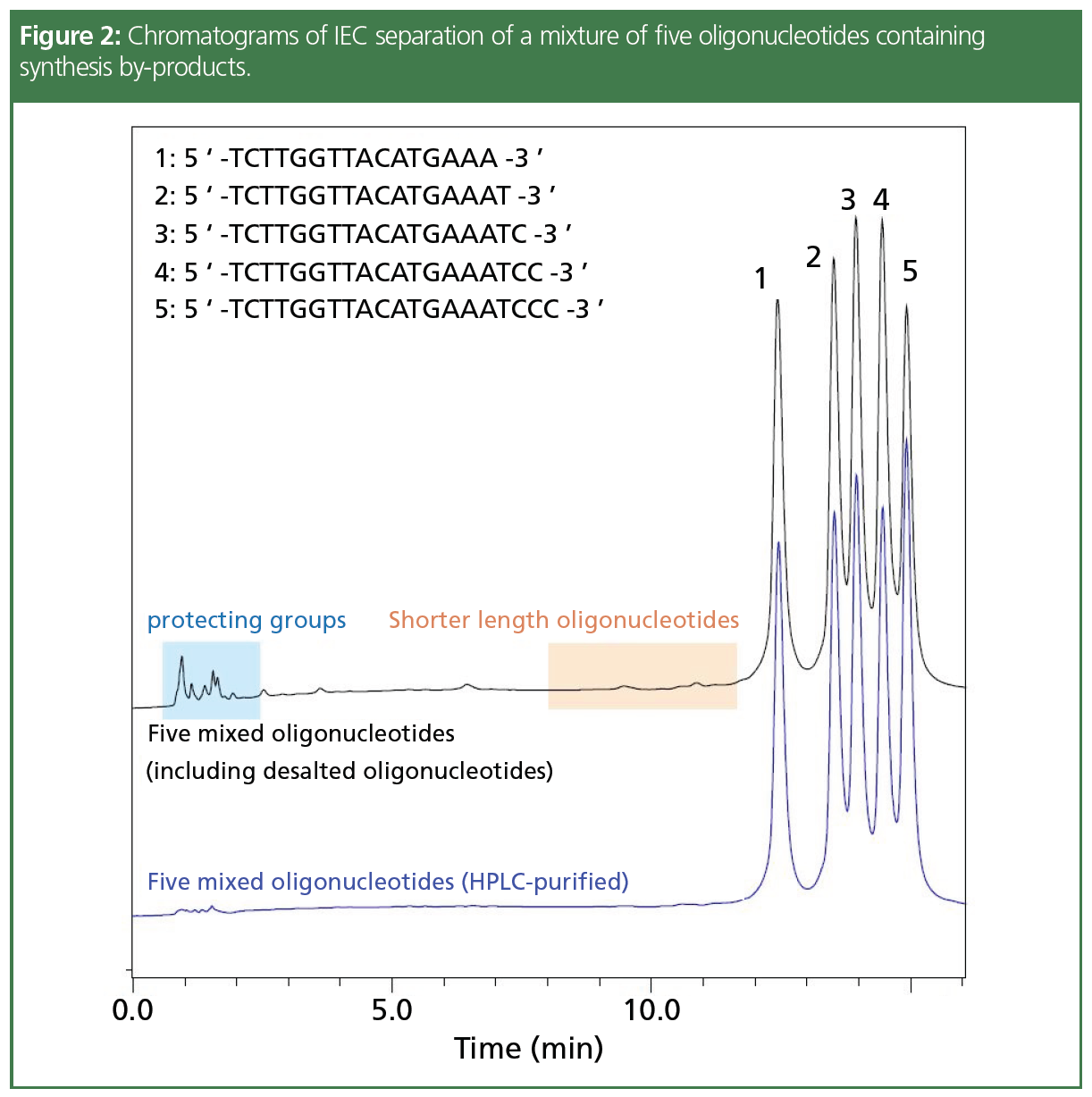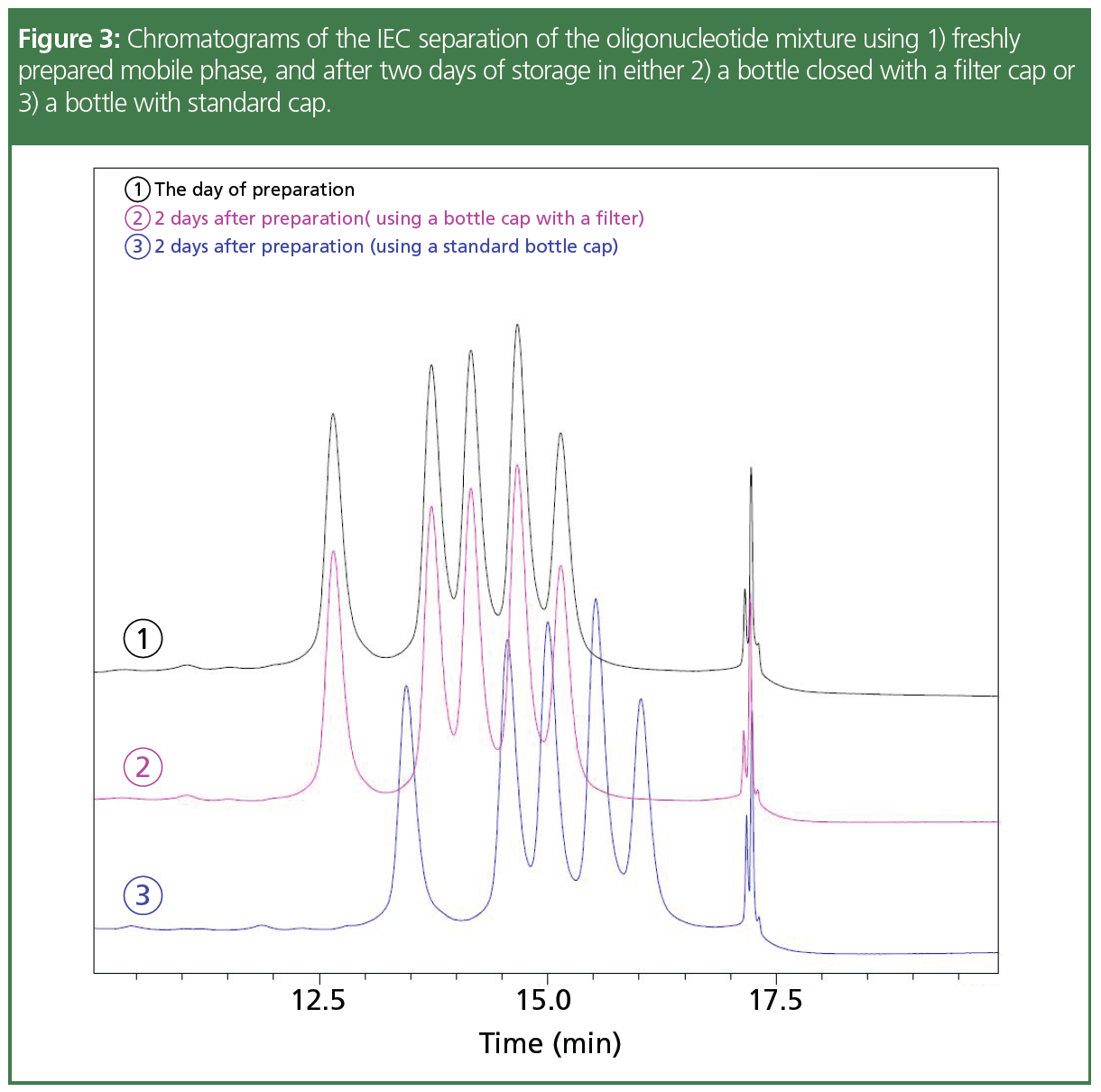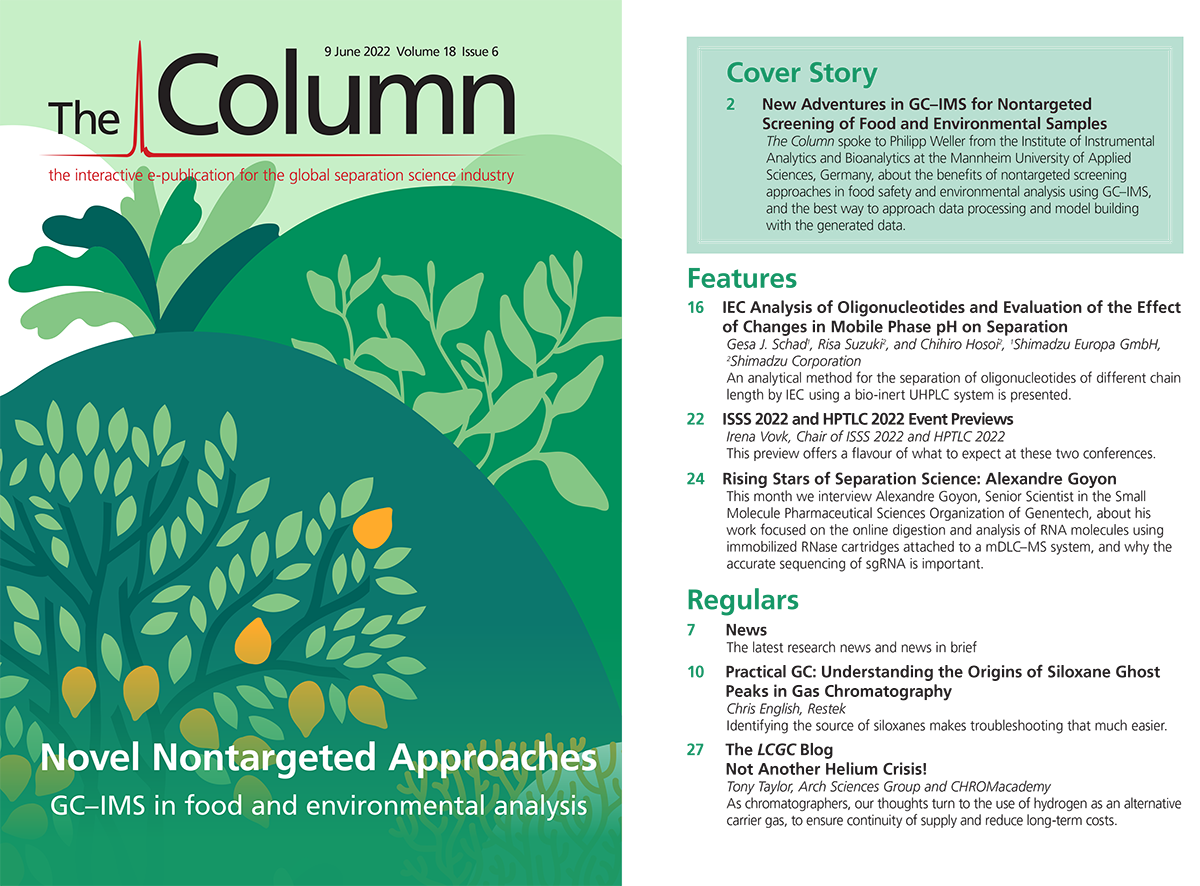IEC Analysis of Oligonucleotides and Evaluation of the Effect of Changes in Mobile Phase pH on Separation
Chemical synthesis of nucleic acids can result in a number of by-products, such as shorter length components and protecting groups. Therefore, adequate separation and purification of the target compounds is a crucial step in the production process. This article introduces an analytical method for the separation of oligonucleotides of different chain length by ion‑exchange chromatography (IEC) using a bio-inert ultrahigh-pressure liquid chromatography (UHPLC) system. The effect of changes in mobile phase pH due to CO2 absorption from ambient air during storage was also investigated.
Antisense oligonucleotides are a variety of nucleic acid drugs, synthetic molecules with a chemical backbone structure composed of deoxyribonucleic acid (DNA) or ribonucleic acid (RNA) bases. Therapeutic oligonucleotides have become more prominent over recent years because they can be designed to accurately target a specific disease gene or its encoded messenger RNAs, providing the next generation of therapeutics. While having the targeted specificity of antibody therapeutics, they can also be synthesized chemically like “low-molecular‑weight” drugs, which reduces manufacturing costs compared to the biological process of protein-based biomedicines. Therapeutic oligonucleotides combine some of the best properties of “low‑molecular-weight” therapies and biopharmaceuticals.
Chemical synthesis of nucleic acid results in a number of by-products, such as shorter length components and protecting groups (1). Therefore, adequate separation and purification of the target compound is a crucial step in the production process.
This article presents an analytical method for the separation of oligonucleotides of different chain length by ion-exchange chromatography (IEC), assuming that shorter length components are impurities derived from the synthesis process. To avoid any adsorption of the metal-coordinating compounds to the wetted surface of the instrument, a bio-inert ultrahigh-pressure liquid chromatography (UHPLC) system was used. The effect of mobile phase pH on the separation was also investigated.
Materials and Methods
The sequence of the oligonucleotide to be analyzed is shown in Table 1. Target oligonucleotides in 20 mer and four sequences that were deleted from n-1 to n-4 on the 3’ terminus of the target were prepared as impurities derived from the synthesis. All of them were unmodified single-stranded DNA and were synthesized by a solid-phase synthesis (high performance liquid chromatography [HPLC] purification). These five sequences were diluted to 5 μmol/L with water, and an oligonucleotide mixture was prepared.

In ion-exchange chromatography, analytes are separated and eluted using a mobile phase of varying salt concentration or pH. In this analysis, an aqueous solution of sodium hydroxide (A) was used in a gradient with a solution of sodium hydroxide containing sodium perchlorate (B), to gradually increase elution strength for the analytes of interest. A detailed description of analytical conditions is listed below.
Analytical Conditions: System: Nexera XS inert (Shimadzu); column: 100 mm × 4.6 mm, 5-μm Shim-pack Bio IEX Q-NP (Shimadzu); mobile phase A: 10 mmol/L NaOH, mobile phase B: 10 mmol/L NaOH containing 1 mol/L NaClO4; time program: 25%B–32.5%B (0–15 min) " 100%B (15–20 min) " 25%B (20–25 min); flow rate: 0.8 mL/min; oven temperature: 30 °C; injection volume: 4 µL; detection: UV 260 nm.
Using these IEC conditions, separation occurred based on the difference in negative charge of the analytes, which was equivalent to the number of phosphate groups in the oligonucleotide. Consequently, shorter oligonucleotides eluted first. Figure 1 shows a chromatogram of a five-sequence oligonucleotide mixture; all compounds of interest were separated by their length.

Repeatability of the method was determined based on retention time and peak area from six successive analyses of the 16–20 mer oligonucleotide mixture shown in Table 1. With variation of ≤ 0.5% in retention time and peak area for all analytes, good repeatability of the assaywas established. Detailed results can be found in Table 2.

Discussion
Sample Analysis: Oligonucleotides in the Presence of By-Products: A mixture of five oligonucleotides, at 5 μmol/L concentration each, was prepared (four of them were HPLC-purified while one was only desalted) and IEC results were compared to those of the mixture of all HPLC-purified nucleotides (Figure 2). The target oligonucleotides were completely separated from impurities such as free protecting groups and shorter length oligonucleotides.

Effect of Change in Mobile Phase pH on Retention: As described above, in the IEC separation of an oligonucleotide mix, the analytes were separated and eluted using a salt concentration gradient. In an aqueous mobile phase (pH ≥ 7), absorption of carbon dioxide from ambient air can change the effective concentration of a basic eluent due to the formation of carbonic acid (2). In IEC, where separation is based on the analytes’ differences in charge, even a slight change in the pH can have a significant impact on retention and hence the analytical results. It is therefore crucial to prevent possible changes in mobile phases pH, to ensure reliable, stable analytical performance.
In this study, results obtained using mobile phase stored in a bottle closed with a standard screw cap were compared to those achieved with a mobile phase from a bottle with a filter cap that suppresses evaporation of the solvent. Analyses were performed using freshly prepared mobile phase and after two days of storage, both using the conditions described earlier. A comparison of chromatograms obtained are shown in Figure 3. Figure 4 depicts the percentage of change in mobile phase pH during the two days of storage under the respective conditions.

As can be seen in Figure 3, when using a standard mobile phase bottle cap 3), the retention time increased by an average of 8% as the pH changed compared to that on the day of preparation of the mobile phase 1); when using a cap with a filter 2), the retention time did not change significantly. The use of a cap with a filter suppressed the change in the pH of the mobile phase, resulting in stable results, even after two days of mobile phase preparation. Also, the change in pH was measurable in the bottles with a standard cap, with a larger impact seen in mobile phase B containing sodium perchlorate, as shown in Figure 4.

Conclusion
A simple gradient method for the analysis of oligonucleotides by ion-exchange chromatography using a bioinert UHPLC system has been presented. Good separation of the oligonucleotides under investigation was achieved, both from one another and from impurities such as protecting groups and shorter length oligonucleotides, which are common by‑products from chemical synthesis. It was shown that even small changes in eluent pH did affect the analytes’ retention time. Therefore, it is important to carefully control the mobile phase pH to obtain reproducible, reliable results.
References
- C. Hosoi and R. Suzuki, Shimadzu Corporation Application News No. 01-00227-EN (Shimadzu Corporation, February 2022).
- J.S. Fritz and D.T. Gjerde, Ion Chromatography, Third, completely revised and enlarged edition, (Wiley-VCH Verlag GmbH, 2000).
Gesa Johanna Schad graduated with a diploma in chemical engineering from the Technical University NTA in Isny, Germany, in 2004 and as a master of science in pharmaceutical analysis from the University of Strathclyde in Glasgow, UK, in 2005. She worked until 2006 as a consultant in HPLC method development and validation in an analytical laboratory of the FAO/IAEA in Vienna, Austria. She gained her doctorate for research in pharmaceutical sciences at the University of Strathclyde in 2010 and was employed as an HPLC specialist in the R&D department at Hichrom Ltd in Reading, UK, from 2009. Since 2013, she has worked as a HPLC product specialist and since 2015 as HPLC Product Manager in the analytical business unit of Shimadzu Europa in Duisburg, Germany.
Risa Suzuki received her Ph.D. at the University of Tokyo, Japan, in 2015, focusing on protein engineering and construction of a universal screening system for elucidating enzyme functions involved in drug metabolism. From 2015 to 2017 she worked as a postdoctoral research associate at Nagoya University and Tokyo Institute of Technology, working on a JST funded ALCA project on microbe reaction engineering. In 2017, she was employed as a project assistant professor in the School of Medicine at the University of Tokyo. Her research interests and expertise encompass the developing and manufacturing of biopharmaceuticals and crystal structure analysis of proteins. She now works for Shimadzu Corporation in Kyoto, Japan, as a member of the Healthcare Solution Unit in the Solutions COE.
Chihiro Hosoi graduated with a master’s of engineering from the Tokyo University of Agriculture and Technology, Japan, in 2019, focusing on interaction between nucleic acids and proteins and developing a biosensing system. In 2017, she studied graphene-based biosensors at the University of California, Riverside, USA. She now works for Shimadzu Corporation in Kanagawa, Japan, as a member of the Healthcare Solution Unit in the Solutions COE.
E-mail: shimadzu@shimadzu.eu
Website: www.shimadzu.eu

Accelerating Monoclonal Antibody Quality Control: The Role of LC–MS in Upstream Bioprocessing
This study highlights the promising potential of LC–MS as a powerful tool for mAb quality control within the context of upstream processing.
Common Challenges in Nitrosamine Analysis: An LCGC International Peer Exchange
April 15th 2025A recent roundtable discussion featuring Aloka Srinivasan of Raaha, Mayank Bhanti of the United States Pharmacopeia (USP), and Amber Burch of Purisys discussed the challenges surrounding nitrosamine analysis in pharmaceuticals.

.png&w=3840&q=75)

.png&w=3840&q=75)



.png&w=3840&q=75)



.png&w=3840&q=75)














